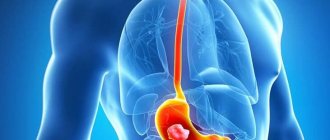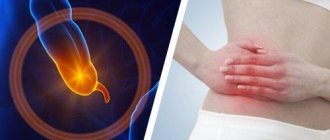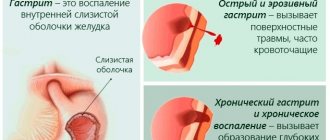What is stomach acidity
Stomach acidity (saturation of digestive juice with hydrogen chloride) indicates the correct functioning of the gastrointestinal tract. The numbers are determined in PH (a coefficient characterizing the conditional activity of hydrogen ions). Hydrochloric acid is secreted by parietal cells located in the stomach.
Creates a hydrogen-rich environment required for:
- crushing protein compounds of food (ground products are easily absorbed into the intestines);
- activation of the production of digestive enzymes (peptin is produced only when hydrogen compounds are activated);
- ingestion of iron, vitamins, folic acid from food consumed;
- carrying out antimicrobial cleansing of eaten food;
- participation in the metabolism of acids and alkalis in the body.
At the beginning of the digestive tract, a large number of pathogenic microorganisms are concentrated, entering the esophagus along with the food consumed. Gastric juice destroys bacteria, helping the breakdown and absorption of beneficial microelements.
If the acid-base balance is disturbed, dysfunction of the digestive process occurs, and there is a danger of:
- infection of the body (high pH values);
- injury to the epithelial tissue of the stomach (fraught with an increase in the amount of HCL, a decrease in pH levels), with the subsequent formation of erosions, ulcers, and bleeding.
An analysis to determine the components of gastric juice is prescribed in case of pain caused by problems with the breakdown and digestion of food. An acidic environment (peptin) is necessary for the formation of enzymes, but food must be neutralized before entering the small intestine.
Measuring the numbers that determine the acidity of the stomach allows you to timely detect disruptions in the mechanical and chemical processing of food, eliminate painful symptoms, and prevent the development of gastrointestinal diseases.
Stomach acidity indicators
Hydrogen chloride found in the gastrointestinal tract is unchanged - 160 mmol/l. Acidity - data indicating the ratio of hydrochloric acid produced and alkaline salts (metals) designed to neutralize the aggressiveness of HCL. Variation in the saturation of the constituent components determines the high or low level of acidity.
Subacidity (acidity) of the stomach is measured in pH:
- 1РН – shows the largest amount of HCL;
- 7РН – the value of a neutral environment, an ideal balance between acid and alkali;
- 14 pH – almost completely alkaline environment.
The values of subacidity of the body are not constant, they change depending on the time of day, food consumption, and human activity. In the morning (before breakfast), after prolonged abstinence from food, the value is 4 pH. After eating, the production of hydrogen chloride increases, the pH value drops to 1-2.
Normal acidity level:
| optimal | maximum | minimum | atrium | epithelial layer | neutral number |
| 1,6-2,1 | 0,87 | 8,4 | 1,4–7,6 | 7,2 | 7,3 |
Acidity is studied in three parts of the gastrointestinal tract:
- Upper (acid zone) – represents the body and fundus of the stomach. Hydrochloric acid is produced here, as a result of which this department is characterized by a high level of hydrogen chloride (1.5-2.3 pH).
- Lower (antrum) - responsible for neutralizing HCL before the crushed food enters the small intestine. Normal values range from 4.7–7.5 PH.
- Intermediate (intermediate zone) – 6.1–3.6 pH.
An increased number of HCL in the digestive juice (decreased pH values) means that the acid secreted by cells exceeds the norm. The predominance of alkaline components, characterized by an active increase in pH (especially for the upper section) is grounds to assume reduced subacidity.
Methods for determining stomach acidity at home
You can independently find out the acidity of the stomach at home, focusing on internal sensations, using a pharmacy test or certain foods:
According to internal signs and sensations
How to find out the acidity of the stomach at home will be indicated by symptoms indicating a violation of the digestive process. When the amount of HCL is low, fermentation occurs in the intestines. The food eaten does not have time to be digested and accumulates, provoking the appearance of bacteria that affect the gastrointestinal tract.
Signs indicating the development of low acidity include:
- Change in taste sensations. There is a previously uncharacteristic desire to consume foods containing ascorbic acid.
- The appearance of belching with a rotten smell.
- Flatulence caused by fermentation processes. The occurrence of gas is accompanied by cramps in the lower abdomen.
- Discomfort in the diaphragmatic area.
- Pain after eating.
- Diarrhea resulting from the ingestion of gastrointestinal microbes.
- Acne.
- Dry skin.
- Hair splitting, nails peeling.
- Weakening of the immune system due to the constant opposition of the leukocyte system to toxic substances accumulating in the body.
The large amount of acid produced by the cells is characterized by pain caused by the release of HCL into the esophagus.
An increase in the percentage of hydrogen chloride causes:
- Discomfort and burning behind the sternum, neutralized by drugs, milk, baking soda.
- A metallic taste appears in the mouth.
- The occurrence of hunger cramps is a reaction to the lack of food. Most often, an unpleasant symptom appears in the morning (it is eliminated with the consumption of any amount of food).
- Sour belching.
- Coating of the tongue with a yellowish coating with gray patches.
- Afternoon diarrhea.
- Headache with dizziness.
Using litmus paper
A pharmacist will tell you how to find out the acidity of the stomach at home, suggesting using a text based on litmus. A pharmacy instrument helps characterize the components that make up the digestive juice using paper colored with an indicator (lichen squeeze). Subacidity is determined in accordance with the scale drawn on the package with the test.
The most reliable way to find out the acidity of the stomach is with the help of indicator strips.
To determine the level of stomach acidity, litmus paper must be applied to the tongue and left in this position for 1-2 seconds.
The color of the indicator determines the saturation of hydrochloric acid:
- purple tint means normal;
- red, pink proves the development of increased acidity;
- blue indicates alkaline composition (low acidity).
Test rules:
- The study is carried out in the morning (from 10:00 to 12:00). During this period, the content of hydrogen chloride in the body increases and salivation slows down. In the evening, significantly less HCL is produced.
- Before the test, you should refrain from eating for at least 2 hours.
- On the day of the test, you should not consume acidic foods, carbonated drinks, or fruit juices. You are allowed to drink only water that does not contain gas.
The litmus test is not 100% guaranteed.
Its effectiveness is influenced by:
- previously eaten foods;
- salivation rate;
- internal features of the body.
For a more accurate result, it is necessary to carry out the analysis 3-4 days in a row at the same time. The diagnosis is made after studying the summary data for the entire study period.
Using millet porridge
How to find out the acidity of the stomach at home is indicated by some food products, the consumption of which provokes an active reaction in the body.
Subacidity can be easily determined by eating warm millet porridge with the addition of butter fat. People suffering from high acidity levels complain of severe heartburn after consuming this dish.
With lemon
Citrus fruits contain vitamin C. Patients with low acidity enjoy eating lemons. After eating the fruit (with a lack of hydrogen chloride), a pleasant aftertaste appears. If there is high acidity, a person cannot eat a slice of lemon. Ascorbic acid will cause discomfort, heartburn, and belching.
Using natural apple juice
The test using freshly squeezed apple juice should be done before breakfast. During the study, a hungry patient drinks 200 ml of the drink.
Test performance:
- the occurrence of spasms and pain in the peri-umbilical region, radiating to the sternum, indicates an increased level of acidity;
- absence of unpleasant symptoms - indicates normal acid-base metabolism;
- the emerging desire to drink another glass of juice is characterized by the predominance of alkaline salts and metals in the composition of gastric juice.
Using other products
Sodium bicarbonate (baking soda) (1/2 tsp) dissolved in drinking water (200 ml) is taken on an empty stomach (preferably in the morning). In people with normal acidity, the drink will cause belching. If the consumption of the mixture went well, then the patient will experience a reduced level of acidity.
Checking acidity by symptoms
Increased or decreased stomach acidity is determined by symptoms. High acidity causes negative disturbances in the condition of organs. The acid irritates the surface of the digestive organs, which is why the following symptoms develop:
- Heartburn is the uncontrolled release of gastric juice into the esophagus. This happens suddenly and without any reason. A large amount of acid is formed due to the consumption of certain foods.
- Sour taste in the mouth . Sour saliva is formed at the sight and smell of sour food: apples, sauerkraut, lemon, and so on.
- Belching . Appears for no reason, but after eating fried, spicy and fatty foods. It can also be triggered by constant consumption of sweet foods.
- Pain in the stomach area of a pulling, aching and dull nature. Strongly expressed during the hungry period and in the morning. After eating edibles, they subside.
- Heaviness in the stomach . And even bloating occurs after a light snack.
- Constipation or diarrhea . They discourage eating in general, because after this they feel a strong stomach ache.
- Treatment with anti-inflammatory drugs . Nausea and stomach pain occur immediately after taking the drug.
In addition to these symptoms, there may be other manifestations of increased acid production:
- Headaches immediately after eating smoked, fried and fatty foods.
- Decreased or loss of appetite.
- Sad mood, indifference and powerlessness.
- Feeling irritated.
- Nausea and vomiting are possible.
- A whitish-gray coating on the surface of the tongue.
If there are no these symptoms, then acidity is normal. When these symptoms still appear, you need to visit a gastroenterologist.
Insufficient presence of hydrochloric acid in the gastrointestinal tract also causes unpleasant consequences. It neutralizes food entering the stomach from harmful microorganisms and bacteria. With a low acid content, this process is disrupted and harmful bacteria begin to grow in the stomach. The inflammatory process of the surface of the stomach begins.
Symptoms of low acidity are expressed in the following factors:
- Belching with an unpleasant odor, similar to a rotten egg. There is a smell from the mouth with signs of rot.
- Bloated belly. The presence of bloating, fermentation and rumbling in the gastrointestinal tract. Flatulence and pain from accumulated gases.
- Heartburn.
- Heavy sensations under the ribs.
- Dull pain at the navel after eating or a little later.
- Bursting from the inside.
- Intestinal upset – both diarrhea and constipation are equally troubling.
A small amount of acid leads to insufficient absorption of proteins, which causes breakdown products to accumulate in the stomach and affect the body with toxins. Immunity decreases, which makes it possible to suffer from various infections. The body does not absorb vitamins and minerals well. Therefore, the following changes begin to develop:
- Dry skin.
- Nails peel and grow poorly.
- Hair becomes thin, brittle and dry.
- Acne forms.
With prolonged pathology, loss of strength, weight loss, low blood pressure and simply weakness occur. This is the importance of the question - what is the acidity in the gastrointestinal tract and how to see for yourself what its level is.
What are the dangers of high and low stomach acidity?
The production of hydrochloric acid is aimed at activating the appearance of enzymes. HCL helps disinfect and break down food. The composition of digestive juice characterizes the work of the gastrointestinal tract in the mechanical and chemical processing of food.
Changes in subacidity indicators are affected by:
- stress;
- consumption of alcohol and cigarettes;
- binge eating;
- preference for fatty, fried, carcinogen-rich foods;
- nervous tension;
- insomnia;
- seasonal lack of vitamins.
Increased acidity is fraught with an increase in the activity of cells to produce HCL, leading to injury to the epithelial tissue lining the gastrointestinal tract.
With prolonged irritation of the mucous membrane, the following may appear:
- ulcerative defect on the walls of the stomach and duodenum;
- gastritis;
- stomach bleeding;
- gastroduodenitis.
Most often, high acidity occurs when a Heliobacter infection enters the body, which is responsible for the appearance of ulcers and cracks in the mucous walls of the stomach and intestines.
The bacterium is not destroyed under the influence of hydrochloric acid, causes artificial alkalization , provokes additional production of hydrogen chloride, leading to severe injury to the epithelial tissue of the gastrointestinal tract.
Low acidity is caused by stress and overeating. The predominance of an alkaline environment leads to a decrease in the protective properties of gastric juice, a decrease in enzyme productivity, stagnation and fermentation processes in the intestines, leading to intoxication of the gastrointestinal tract and the entire body (occurs when poisons enter the circulatory system).
An increase in alkaline components is fraught with the development of:
- iron deficiency anemia;
- lack of vitamins, folic acid, minerals;
- oncology.
Prevention of acidity
To prevent the occurrence of gastrointestinal pathology, the patient must follow several rules and recommendations from the doctor:
- Eat right, the daily menu should be balanced, enriched with vitamins and minerals.
- You will have to eat foods containing fiber.
- You need to eat in small portions and completely avoid spicy, fatty foods.
- To refuse from bad habits.
- Undergo medical examinations for preventive purposes.
- Avoid psycho-emotional shocks.
- Conduct timely drug therapy for any pathologies.
If the patient has questions, he should consult a doctor to clarify possible adjustments to his lifestyle and diet.
At home, determining the acidity content in the stomach is possible only for advisory purposes. All information is only conditional and indicates significant deviations. Reliable results can only be obtained in a medical institution under the supervision of the attending physician. To determine a treatment regimen and correct your health, you will have to seek the help of a specialist.
If an increase in acidity occurs only from time to time, then such a condition extremely rarely leads to serious consequences. But if elevated levels are observed regularly, this can lead to serious illnesses. In this regard, it is very important to observe the following preventive measures:
- Correctly, and, in addition, eat rationally. You should eat a lot of foods that contain fiber and proteins with vitamins. It is recommended to take food in small portions, excluding fatty and spicy foods. Dishes from the fast food category should be specifically prohibited.
- It is equally important to give up smoking and, in addition, drinking alcoholic beverages.
- Regular screening for the presence of Helicobacter pylori infection should be carried out.
- You should try to avoid stress and nervous tension.
- Carry out timely treatment of pathologies of infectious origin, as they can lead to the development of complications.
How to normalize acidity
Deviations from normal pH levels can be eliminated by following a diet and prescribing medications.
Treatment of high acidity
To reduce the production of hydrogen chloride, a diet excluding fats and vitamin C is indicated.
Allowed to eat:
- lean types of meat, fish, poultry, preferably cooked in a double boiler, boiled, baked in the oven;
- porridge from rice, corn, oatmeal;
- strained chicken broth;
- boiled shrimp, octopus, squid, without salt and spices;
- root vegetables, fruits rich in fiber (pears, bananas, apples);
- milk (it is advisable to drink 200 ml on an empty stomach).
It is prohibited to consume:
- fruit and vegetable dishes containing ascorbic acid, legumes, radishes.
- cheese, cottage cheese, sour cream;
- fatty, fried, salty foods;
- carbonated lemonade;
- coffee, chocolate;
- alcoholic drinks;
- pickles and marinades;
- smoked meats;
- fast food;
- spices, vinegar.
In addition to special nutrition, medications are prescribed to reduce the secretion of hydrochloric acid and protect the mucous membrane of the stomach and intestines:
| Group of drugs | Pharmacology | Name of medicines |
| Antacids | Aimed at protecting the epithelial tissue of the esophagus and stomach. They differ in: 1. Suction – eliminating excess hydrogen chloride entering the stomach. They have one-time activity. Contains sodium bicarbonate and burnt magnesia. 2. Non-absorbable – envelop the gastrointestinal mucosa, protecting against injury and the aggressive action of HCL. |
|
| ||
| Anti-sector | Reduce the release of hydrochloric acid by blocking the activity of parietal cells | H2-histamine blockers:
|
Proton pump inhibitors:
| ||
| Gastroprotectors | Protects the mucous membrane of the stomach and duodenum Protects the mucous membrane of the stomach and duodenum |
|
Treatment of low acidity
The alkaline chemical composition of digestive juice requires the appointment of special nutrition and complex drug therapy, including additional consumption of vitamin and mineral complexes. During treatment, meals are indicated 5–6 times a day.
Allowed consumption:
- sauerkraut;
- fruits, berries, rich in vitamin C;
- cottage cheese, cheeses, sour cream, kefir;
- lean types of meat and poultry;
- liquid dairy-free cereals;
Forbidden:
- milk;
- pickles;
- seasonings;
- fatty food.
Medications:
| Group name | Pharmacology | Name |
| Hydrogen chloride production stimulants | Activate the functioning of cells that synthesize HCL |
|
| Substitutes | Contains artificial components (enzymes, HCL) |
|
| Herbal preparations | Activate the production of hydrochloric acid | Plantaglucide |
Subacidity is an indicator that assesses the functioning of the gastrointestinal tract. Having learned the exact value of stomach acidity at home, it is easy to change your daily diet and prevent the occurrence of serious pathologies of internal organs.
Article design: Mila Friedan
How doctors check
How to check the acidity of the stomach using medical methods is the most common question when you want to carry out the procedure at home. It should be noted that the norm of hydrochloric acid in gastric juice is 0-9 mmol/h. Stomach acidity in the hospital is tested in the following ways:
- Determination of stomach acidity by staining urine . To do this, you need to take a test, where the acidity of urine is calculated using the scale included with the kit. The method does not provide true information, so it has not been used recently.
- Fractional intubation of the stomach . To get tested, you will have to go through an unpleasant procedure. It is done by collecting gastric juice through a tube and examining it in the laboratory. The juice is mixed during collection, because it is taken from all parts of the stomach. Therefore, the analysis results are approximate.
- Internal pH-metry . The most accurate and informative way to calculate the acidity level. Using a device - an acidogastrometer, which has many pH probes and sensors, the indicator is determined simultaneously in all parts of the gastrointestinal tract.
To measure stomach acidity using the methods described, you must contact a medical laboratory. But everyone should know how to determine stomach acidity without gastroscopy.











